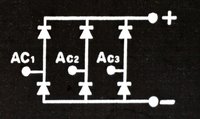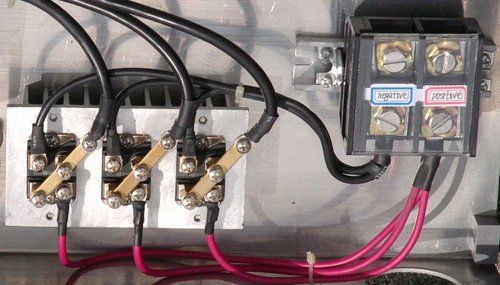Rectifier
|
|
A rectifier is an electrical device, comprising one or more diodes arranged for converting alternating current (AC) to direct current (DC).
When just one diode is used to rectify AC (by omitting the negative portion of the waveform) the difference between the term diode and the term rectifier is merely one of usage, e.g. a rectifier depicts a diode that is being used to convert AC to DC.
However, almost all rectifiers comprise a plurality of diodes in a specific arrangement for more efficiently converting AC to DC than is possible with just a single diode.
Full wave rectifiers reverse the negative portions of the alternating current waveform. The positive portions thus combine with the reversed negative portions to produce an entirely positive current.
For single phase AC, if the AC is center-tapped, then two diodes back-to-back (i.e. anodes-to-anode or cathode-to-cathode) form a full wave bridge rectifier. If there is no center tap, then four diodes, arranged in a bridge, are needed.
For three phase AC, six diodes are used. Typically there are three pairs of diodes, each pair, though, is not the same kind of double diode that would be used for a full wave single phase rectifier. Instead the pairs are in series (anode to cathode). Typically, commercially available double diodes have four terminals so the user can configure them as single phase split supply use, for half a bridge, or for three phase use.
Smoothing
While half- and full-wave rectification suffices to protect potentially damagable components and deliver a form of DC output, neither produces anything like real DC. In order to produce steady DC from a rectified AC supply, a smoothing circuit is required. In its simplest form this can be what is known as a reservoir capacitor, placed between the rectified input p.d. and the DC output. This has, however, the disadvantage of retaining an AC ripple where the voltage is not completely smoothed.
To combat this ripple, a capacitor-input filter can be used. This complements the reservoir capacitor with a choke and a second filter capacitor, so steady DC output can be obtained across the terminals of the filter capacitor, with the choke effectively absorbing most of the ripple.
Rectification efficiency
Rectification efficiency measures how efficiently a rectifier converts AC to DC. It is defined as the ratio of the DC output power to AC input power, where DC output power is a product of the average current and voltage.de:Gleichrichter it:Raddrizzatore es:Rectificador nl:Gelijkrichter pl:Prostownik


